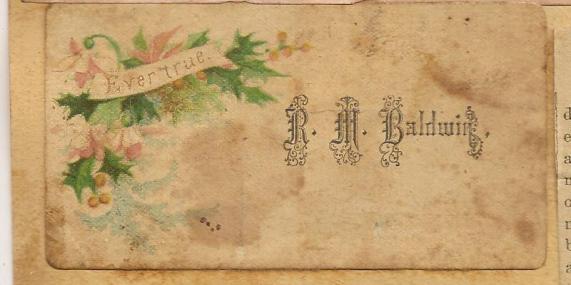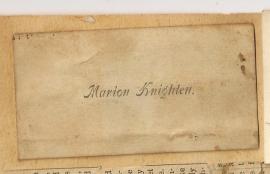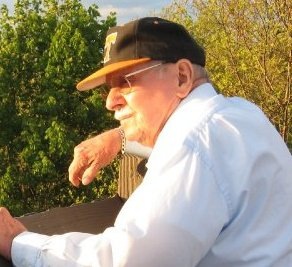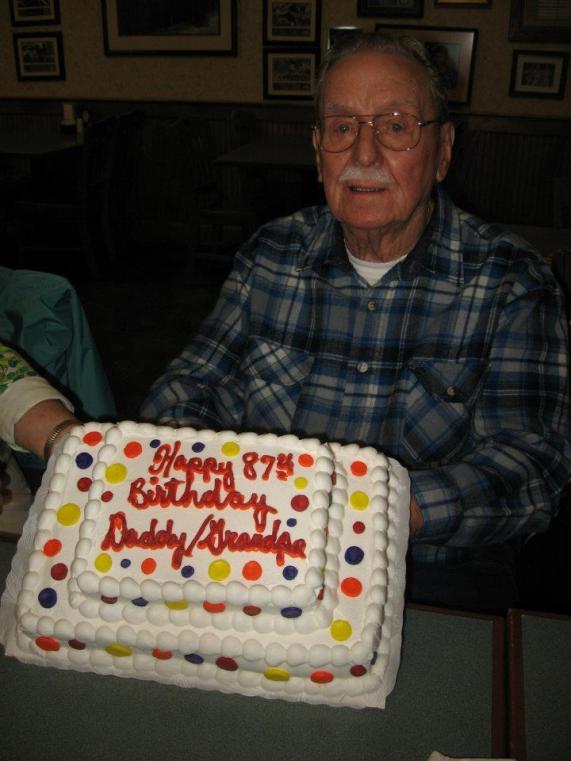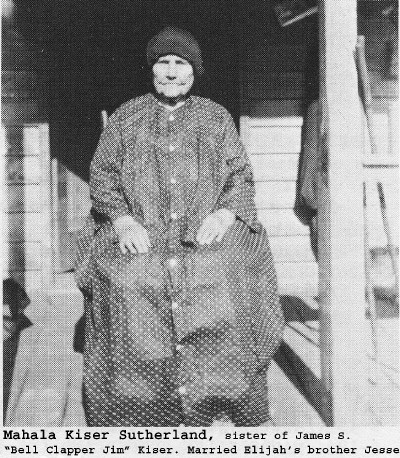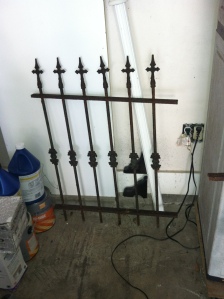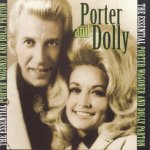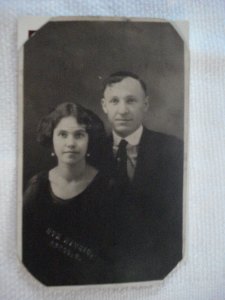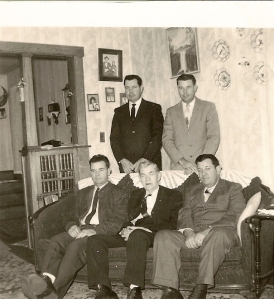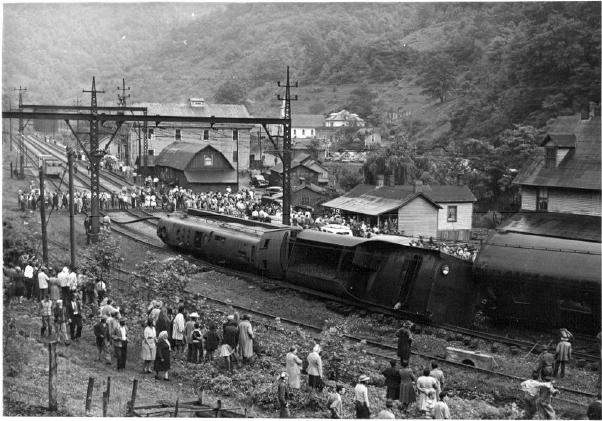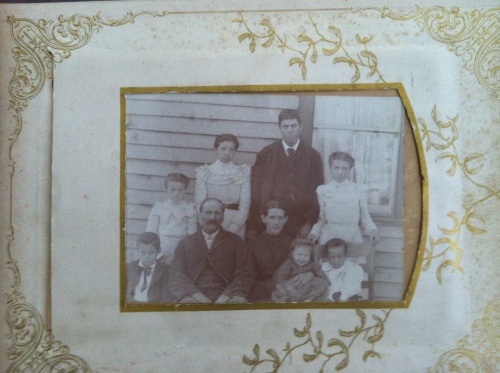Jess and Leanna Kiser on the porch of their Sandy Ridge home (Russell County, Virginia). Jess was known for cracking chestnuts with his bare heels. The young girl may be their granddaughter Effie and the man may be their son-in-law Paris Kiser. (photo courtesy of Harold James Breeding and published in WILDER DAYS).
Two pioneer families settled along the Clinch River in Russell County, Virginia. The Kiser’s and Sutherland’s, (Germans – Scots). According to author and historian Kathy Shearer in her book WILDER DAYS-Coal Town Life on Dumps Creek, (pages 86-87) “Uncle Jess Kiser, would come down from Sandy Ridge to peddle in Wilder. Jess’s sister was Surredly Kiser Sutherland, wife of Elihu Sutherland. (recounted by his niece Kate Parrot) Uncle Jess Kiser, he entertained everybody at the company store. He never put shoes on his feet: he tied sacks around them in the winter; He always danced at the store. He’s witty and they liked him. He was tough and snow didn’t bother him or anything. He would bring us apples and say, Apples if you want’em, apples if you don’t want’em. Mother would say, Jess, what you want this morning? She would fix him some cornbread.”
http://www.findagrave.com/cgi-bin/fg.cgi?page=gr&GRid=48415639
MORE KISER/KEYSER… Source: Materials posted by Mark R. Kiser (MRKiser@aol.com), 23 Mar 1998. Kiser, Joseph, 1756-1816 Joseph Kiser was born about the year 1756 probably in Lancaster County, Pennsylvania. His father, Charles Keyser from Germany, had settled in Lancaster County (1) for a period of time before he acquired land in Frederick County, Virginia in 1765 (2) and area near Hawksbill, later to become Shenandoah County and presently located in Page County, Virginia. On October 8, 1778 he appears in the Page County records when he sued for debt and was awarded 18 shillings and 6 pence plus court cost. On October 10, 1782 the Commonwealth of Virginia granted Joeph Keyser 88 acres of land on the south side of the Clinch River. Marginal notations show this entry marked “void” and “Survd. 50 acres”. The same record shows that on December 18, 1783 he had surveyed 50 acres at the same location. At that time the land was in Washington County, later to become a part of Russell County in 1786. The area he settled became known as Keyser Station, today known as Carbo. In December of 1785 he signed the petition to form Russell County. On March 18, 1793 he purchased 70 acres of land on Becks Branch of Russell County from John Frost and others. On November 24, 1801, Joseph and his wife, Susannah, conveyed to Jacob Burch 50 acres of land on the waters of Clinch River on the north side of Copper Ridge and adjoining Edward Kelly, “it being fifty acres which land was granted by the Commonwealth to said Keiser bearing date the 21st day of November 1792”. Both grantors signed the deed. He was a Russell County juror on April 22, 1789, and also on June 26, 1792. He was allowed 12 shillings, 6 pence for killing one old wolf on February 22, 1791. His estate was appraised by Abraham Childress, James Sutherland, Jacob Blare and William Kelley, and the appraisal was recorded February 6, 1816. Joseph married Susannah Stacey probably in Page County, Virginia but spent most of their lives in Russell County, Virginia where both died, Joseph in 1816. Nearly all his descendants spell their surname Kiser. … (1) Kercheval’s “History of the Valley”, 4th Ed., page 37 relates an incident in relation to which “Major Andrew Keyser also informed the author that an Indian once called at his father’s in Lancaster County, Pennsylvania, appeared to be much agitated, and asked for something to eat. After refreshing himself he was asked what disturbed him. He replied, ‘The Southern Indians have killed my whole nation.'” This indicates clearly that Charles Keyser lived in Lancaster County, Pennsylvania, before he settled in what is now Page County, Virginia. (2) By deed of April 6, 1765, recorded in Frederick County, Virginia, deed book No. 10, page 248, Lewis Rhinehart and Mathias Rhinehart of Frederick County, Virginia conveyed unto Charles Keyser, of the same place, a parcel of land on the South Fork of the Shenandoah, being the lower end of two tracts of land granted to Mathias Rhinehart by deed of February 8, 1764, from the Proprietor’s Office of the Northern Neck of Virginia. NOTE: I have located in a book titled, “Bird-Samuels Paper” that a Joseph Kiser, along with Charles Kiser (Jr.) are listed in Michael Reader’s Company of Dunmore County, Virginia during the Revolutionary War. Dunmore County eventually became Shenadoah County. I believe this Joseph Kiser to be the same Joseph that settled in Russell County, Virginia and he also had a brother named Charles Kiser (Jr.). I have written to the National Archives to obtain records but that were unable to locate any.
Source: Julie Voyles (JVoyles105@aol.com) posted on the Russell Co. List Server information regarding the descendants of Karl Keyser, some of which contradicts information in the above. “Joseph Keyser/Kiser (1756-1818) married Susannah Stacy and they migrated to Washington, Co., VA which became Russell Co. They lived in the same place on the same patch of land all their lives. They are the progenators of our line there in Russell County. Most all their descendants spell their name Kiser.”
More About Joseph Kenton Keyser: Burial: Unknown, Carbo Community Church Cemetery, Carbo, Russell Co., Virginia.
More About Joseph Kenton Keyser and Susannah Stacy: Marriage: 1757, Lancaster Co., Pa.
Children of Joseph Kenton Keyser and Susannah Stacy are:
- +Mary “Polly” Kiser, b. 1794, Russell Co, VA, d. date unknown.
- +John C. Kiser, b. August 08, 1786, Russell Co, VA, d. April 15, 1852, Russell Co, VA.
- Joseph Kenton Kiser Jr, b. June 06, 1782, d. date unknown.
- Abednego Kiser, b. 1784, d. date unknown.
- Nimrod Kiser, b. 1788, d. date unknown.
- Ephriam Noah Kiser, b. 1790, d. date unknown.
- Susanna Kiser, b. 1792, d. date unknown.
- Charles Kiser, b. 1796, d. date unknown.
- Elizabeth Kiser, b. 1798, d. date unknown.
Children of Joseph Kenton Keyser and Susannah Stacy are:
- +John C. Kiser, b. August 08, 1786, Russell Co, VA, d. April 15, 1852, Russell Co, VA.
- Joseph Kenton Kiser Jr, b. June 06, 1782, d. date unknown.
- Abednego Kiser, b. 1784, d. date unknown.
- Nimrod Kiser, b. 1788, d. date unknown.
- Ephriam Noah Kiser, b. 1790, d. date unknown.
- Susanna Kiser, b. 1792, d. date unknown.
- Charles Kiser, b. 1796, d. date unknown.
- Elizabeth Kiser, b. 1798, d. date unknown.
- +Mary “Polly” Kiser, b. 1794, Russell Co, VA, d. date unknown.
MORE SUTHERLAND Source:
Most persons can be identified with one characteristic of special interest. Elihu Jasper Sutherland seemed to have been curious about everything under the sun and developed many talents. From his first known Scotch ancestor, James Sutherland, he inherited the trait of thrift and tenaciousness. From his Germanic grandfather’s great grandfather, John Counts (of Glade Hollow) came the tendency to scholarship and accuracy. From his grandmother’s grandmother, red-haired Irish Peggy Kelly, came his poetic flair. In the veins of his ancestors also came English blood. From all his many ancestors, “EJ” received a rich heritage. I shall review some of the outstanding interests of Elihu Jasper Sutherland and shall often illustrate by quotations. He valued schools. He was a teacher, County School Board Chairman, and counsellor. IN November, 1938, he wrote: “And books – being a younger child. I got the old books as my brother finished with them. I dug ‘sang’ to get my first new books. You can be sure they were precious to me.” “The coming of visitors – the school superintendent riding a prancing horse, trustees often coming on foot, and patrons of the school smiling on all the scholars and bragging on the teacher. Sometimes they gave us short talks about the value of schools – the benefits of being good – making good citizens – their humble advice still helps us over rough spots in the road of life – Do your teachers take time to teach you the Golden Rule and ‘memory gems?’ – to warn you of the dangers of strong drink and bad company? The old teachers taught much along these lines – their labors bore choice fruits.” (1) He was a student of politics. In 1901, “EJ” was sent for three months to Stratton School, twelve miles from home, where his cousin Thurman L. Sutherland was his teacher. In his “School Recollections,” (December 12, 1937), he wrote: “I learned very well from my books, and my outlook on the world was considerably widened by being farther from home and meeting people from other sections. Reading the newspapers and hearing men talk about legal and political questions awakened my interest in these matters.” Writing on party politics later in life, “EJ” gave his opinions and commented, “I have been a Young Democrat a long time – I couldn’t be anything else.” (2) He was a Genealogist. He was a member of the National Genealogical Society. His studies of the Counts and related families are recorded in more than fifty loose-leaf notebooks of original data. He traveled to many courthouses to copy exact records, interviewed relatives or neighbors and secured Bible or other written records about persons. I recall his skill in getting facts from an Incident in 1944 when we were trying to find the Bedford County home of our common grandfather’s grandfather, “Jamie the Scotchman” Sutherland. He had first gotten from the country court records the chain of title of the land our ancestor owned, and it was clear that it was known as the “Alexander Gray Place.” When we approached the location, we asked a man pruning a tree for information. He said he had never heard of James Sutherland, and this was to be expected since “Jamie” sold the land in 1799. He also said he had never heard of Alexander Gray. Then “EJ’s” skill in interviewing came to the rescue. He suggested Alexander might have been called “Alex”. Then the light dawned, “Oh,” said the man who did not know Alexander Gray, “I married Alex Gray’s granddaughter.” Now we were given exact information as to how to go and, with others helping and commenting, we were directed to “two large walnuts near a pile of stones and debris,” near an old graveyard. This was the place where James Sutherland had lived some twenty years before moving to Catawba Creek and later to Carbo on the Clinch River in Russell County, Virginia. (3) He kept accurate records. During his lifetime he collected fifteen picture albums and approximately 125 scrapbooks. Fifty-five of the latter contain Dr. Goodridge Wilson’s “The Southwest Corner,” complete from the first entry (3-31-29) to the present, which Hetty has kept up the past five years. His collection of more than a hundred loose-leaf notebooks (typed pages) include the proceedings of each Counts Reunion from the first in 1936 through 1969; “Recollections” of oldest citizens dating back to the Civil War; Family Bible Records, Church Records, County Court House Records of Virginia, Kentucky and North Carolina; Tombstone Inscriptions; Genealogy; Folk Lore; “Heard on Frying Pan,” Old Letters, A Bibliography of Southwest Virginia, copies of diaries (his own and some others); and his own writings including speeches, accounts of tours and hikes, and “Seen from Sunset Hill.” His diaries began in January, 1904, and I quote from his next to the last entry at Johnston Memorial Hospital on July 3, 1964. “Woke up early. Pretty good night. Breakfast: milk, toast, orange juice, 2 eggs, oatmeal. Dr. Barrow visited. Usual injections. Billy came by and stayed awhile, then went to Emory for Toy. Dinner: milk, potato, fish, tomatoes. Billy and Toy came in awhile; Maxie Mullins and Elsie, Ralph Selfe, Tim Fleming. Supper: milk, liver, lettuce, mashed potatoes, slice watermelon. Robert Lee Barrett placed in my room. Light rain in P. M. Late visitors: Gabe and Tim, Hoge and May. He was a close observer of events and their meaning. In 1941, he edited his old column in The Dickenson Forum entitled, “Seen from Sunset Hill,” with comments on books, seasons of the year, courts, county fair, family reunions, boyhood memories, deaths of older citizens, schools, politics, etc. See “EJ’s” mind in motion as he describes “Payday t the Mines” in 1938: “A drizzly Saturday did not dampen the ardor of the crowds that slopped through the narrow streets, gathered on porches and under the sparing shelter of sickly trees, crowded the commissary, restaurant, postoffice and drug store. All were happy, even boisterous. Cars were parked along the street as far as the eye could see, or honked and twisted and squeezed slowly through the choked thoroughfare – part and parcel of this moving drama of the coal-abounding hills – payday for the sweat and toil of two weeks underground.” “By twelve o’clock lines began to form at the pay windows, little men, big men, old men, young men, women, children fell into line.” “One-thirty – the pay windows opened – the miners or members of their families began filing past. Each signed a slip of paper, and an envelope was thrust out. The recipients stepped aside, carefully opened the packet, counted the contents, smiled a little, and wandered off.” “A crippled beggar sat hunched at the head of the steps, hand outstretched. Another beggar, blind, holding a battered banjo in one hand and a tin cup in the other. Still another blind supplicant strummed a guitar and helped his timid, sad-eyed daughter sing snatches of a plaintive song – it was payday for the beggars too.” “Beggars were not the only ones who held out hands to these toilers – local merchants, car dealers, garage owners, lawyers, collecting officers, tax collectors, etc., waiting for the man with the pay envelope. Quietly and in great good humor, creditors met debtors, exchanged friendly greetings and some crisp bills for scrawled receipts, and passed on – laughter was predominant – there was no disorder.” “In two hours over thirty thousand dollars had trickled out of the company’s till into the hands of miners – this money would go into every corner of the county – thirty thousand dollars each two weeks – sixty thousand dollars each month – three quarters of a million in one year! If this steady stream of cash should suddenly dry up, what would the people do? I wonder – ” (4) He loved farm life. At their Sunset Hill home in Clintwood, “EJ” and Hetty had their own garden and, until the sons went to college, kept a cow and chickens. Hear him recall his boyhood experiences in the Lower Field of his old Frying Pan farm home: “The old rail fence has rotted down; the hillsides and flats are covered with a tangle of briers and young trees. Gone are the corn rows, the wheat shocks, and the timothy cocks. But the old, well-beaten footpath from the Middle Bars to the Lower Barn still leads across the center of the Lower Field. Also, one can see, hidden in the full-leaved bushes, a few rock piles made years and years ago by hands that have passed on and work no more.” “This path still intrigues me – as well as the Lower Field. It was the Way Out – a shining road over the shining fields – on which beckoned glorious adventures and gruesome dangers. It holds many happy memories for those who, as lads and lassies, tripped along in the gaiety of unworried youth to school or church at Sulphur Spring.” “I can see Old Suz, the gray mule that helped raise the family, strain at the gears as she steadily tramps from end to end of the long corn rows pulling a bulltongued plow. Across the field below her, in rows already prepared by the plow, I can discern, moving slowly, slowly, with flashing, clinking hoes, a conglomeration of toilers – from age-bowed Grandpa to little tots useful only to step on hills of corn and beans already hoed or to carry tin buckets of cooling water to the workers. My mother and sisters often helped us in the fields. At noon Old Suz had such acute ears that she was first to hear the shrill call of the dinner horn, and she would instantly start straight toward the house wherever she happened to be.” “We have spent many happy hours hunting in the Lower Field – day and night. In this field we often found signs of foxes, coons, possums, polecats, minks and partridges. One night we lay out all night by a large oak by the edge of the field in which the dogs had treed a coon. At dawn, chilled to the bone but very happy, we watched Grandpa drop the coon from the tree-top with a rifle shot.” (5) He was a prolific writer, and helped get out many publications. In 1935, “EJ” spoke of himself to a Dickenson Memorial High School English class: “Sutherland began to write as soon as he could borrow a piece of chalk and root some weaker fellow pupil away from the blackboard.” “He does not know why he began to write. His recollection does not antedate his desire to read and, when he found out that what he read was just what somebody else had written, he became smitten by the author’s fever to see some of his own thoughts in print. They all get that way.* He has a small volume of poetry, ‘Remembering You,’ in the hands of a printer. He has the following volumes in course of preparation: “History of Dickenson County,” “James Sutherland and His Descendants,” “John Counts and His Descendants,” “John Amburgey and His Descendants,” and “Some Sandy Basin Characters.”** He has planned so much and completed little.” (6) In 1917, he published a 35 page book of poems, “The Sunken Star.” In 1951, he published “In Lonesome Cove,” another volume of poetry. In 1947, he had bound in one volume called “Stray Straws,” seven previous publications. He helped plan and carry out the fiftieth birthday party for Virginia’s “Baby County” in 1930 and, twenty-five years later, edited “Meet Virginia’s Baby.” This pictorial history of Dickenson County, was described by his son Jamie in these words: “The famous official document of the 1955 Diamond Jubilee of Dickenson County** Not just a dry ‘history book’ but a warm human account in words and pictures of the hardy pioneers and their off-spring who hewed out our ‘Diamond in the Wilderness’ from the rough ridges and meager bottomlands of the Sandy Basin.” (7) In 1962, he published “Some Sandy Basin Characters.” At the time of his death, he and the writer were collaborating on another Dickenson County history to include data on schools and some twenty pioneer families. He organized in 1936 the Counts Family Reunion. This reunion of one of Southwest Virginia’s largest families, has been held annually at various locations, except for four years during World War II. It has produced enormous genealogical research on the descendants of John Counts of Glade Hollow, who settled in 1787 near Lebanon in Russell County, Virginia, including Amburgey, Colley, Deel, Fuller, Kelly, Kiser, Rasnick and Sutherland families. “EJ” helped other families with their reunions – as Mullins, Musick, and Smith. The reunions, discontinued during World War II, were renewed at Cleveland, Virginia, in 1946, with “EJ” as President. He inspired and welded the group together. Perhaps no labor of his life gave him greater satisfaction than working with this family organization. I quote from his 1946 address: “The greatest regret that comes to your President at this time is the absence of the faces of so many of our strongest and most beloved supporters and relatives. During the past five years the Grim Reaper has continued to thrust his scythe of death among our people, and its keen blades has found many shining marks. The long list of the Counts Dead, covering the last five years, will be read to you today. You will find that hardly a family has escaped this Death Angel. This is an inexorable law of life. Death comes and reaps – but life goes on in other bodies. When we are gone, others will grasp the flag and move forward. It is the will of God.” (8) He was an authoritative literary critic. The book-lined shelves of his home attest to his life-long quest for any historical data. At an early age he resolved to spend one-tenth of his income on worth-while books, writing (February 8, 1906) in his diary: “One of my most supreme desires has been* to collect a library of choice books* and have them arranged so that they will be a source of comfort and information to me and of interest and recreation to my friends and visitors. God willing, I will accomplish this.” In 1952 he was invited to speak at an Institute of Literature at Radford College on “Literature in Southwest Virginia.” His penetrating review of histories, poems, novels, columns and other written releases was outstanding. He said he had data on at least 2000 literary items from Southwest Virginia, and deplored the poor circulation of our literary materials outside our area. Hear “EJ” tell of adding a new book to his library: “A Narrative of Wise County” by Charles A. Johnson – It has arrived! For months I have been itching to hold it in my hands, to open it slowly, and to feast my eyes upon its satisfying contents. No other event of like kind has ever so firmly held me in its grasp of anticipation.” “Now I have seen it – have handled it – have pored avidly over its pages – have looked with wide eyes into a past that is dead yet liveth. Out of its pages smile faces of men and women who have toiled amid our hill-country and made it a peace and comfort – have dreamed dreams and seen visions that have amazingly come true – have laughingly faced vast dangers and chilling adversities and come forth conquerors over them all, to leave to the sons and daughters thru the ages a record of honor and a land of promise and fulfillment – an engrossing chronicle ably told – an authentic cross section of the life of our own people by the facile hands of one of the actors in the picture unfolded – a story of the rich and poor, the white and the black, the saint and the sinner.” (9) He was a master of description of facts and events. His grandparents had helped settle the Sandy Basin. He talked with many persons and secured their “Recollections” of pioneer days. He saw with his own eyes most of the changes that came to his native county on the very headwaters of the Basin. In spite of multiple responsibilities, he went to more funerals, meetings or other important events than most people do. He joined a vast throng near Carbo, on Clinch River, June 30, 1934, gathered at the home of “Aunt Rachael” Kiser, a granddaughter of “Jamie the Scotchman” Sutherland, to observe her one hundredth birthday. He thought on the changes that had come during this centenarian’s lifetime and wrote: “In this immediate neighborhood she has lived her whole long life. She is the last of her generation. All her twelve brothers and cousins are dead. She has helped rear four later generations, and is now the only living link on the Clinch that connects the Jackson era with the Roosevelt era. Over these long years she has seen startling changes. The forests have been pushed back to the hill-tops and even they have only scrubby trees and bushes; new fields have been cleared and new houses built in every direction; gone are the wolves, the bear, the deer and other big game, leaving only a few marauding foxes and scudding rabbits; bridle paths have changed to hazardous wagon roads, and they in turn have widened and straightened into modern highways, many of them hard-surfaced and permanent; automobiles and trucks have chased the horse-drawn vehicles from the roads; water-mills are almost gone, vanquished by the gas engine; log cabins have disappeared and in their places have appeared painted bungalows, or flimsy slattern boxed hovels the railroad, built in 1890 along Clinch River in sight of Aunt Rach’s door has brought transportation and wealth to farmers and stock raisers; numerous farm and home conveniences have lightened and quickened the labors of the whole family; many of the younger generations have gone out from this little community to people the whole nation. Verily she has watched the face of the country, and the lives of the inhabitants, change immeasurably during the last hundred years.” (10) He helped gather and preserve examples of our mountain folk-lore. In his collection “Folk Games from Frying Pan Creek,” published in Southern Folklore Quarterly in December 1946, “EJ” defends his heritage and contends that some of the old plays were used by the nobility of England and Scotland centuries ago, and that they were “good enough” for our American grandparents. All older Frying Pan settlers knew them. The Library of Congress has many recordings of folk songs gathered with “EJ’s” aid in the county. One of the singers was Mrs. Hetty Austin Swindall, his wife’s aunt. A duplicate of Mrs. Swindall’s songs, preserved in the Library of Congress, has just been secured by his granddaughter. An old song, “Needle’s Eye,” was also known in North Carolina and Kentucky. Jesse Stuart took a line from it as title for one of his books, “The Thread That Runs So True,” the story of a Kentucky mountain school teacher: “Needle’s eye, you must supply The thread that runs so true; I have gained all that is in this house, Now I have just gained you.” (11) He published in 1940 in the Southern Folklore Quarterly, “Vance’s Song.” Richard Chase depended on him in his search for folklore of the Appalachian Mountains. Dr. Arthur Kyle Davis of the University of Virginia found his folklore collection of the best. He helped organize the Historical Society of Southwest Virginia. As an officer, he wrote the Constitution and By-laws adopted by this society March 17, 1961. With membership of approximately one hundred, the society promotes historical studies and preservation of manuscripts. Its meetings rotate quarterly between the six counties it serves – Buchanan, Dickenson, Lee, Russell, Scott and Wise. Four publications have been released by the society. The first, containing one sketch and pertinent information about the society, was prepared and placed in the hands of the publisher by “EJ” who did not live to see it come off the press. Each of the other three contains some eight to ten sketches. His will stipulates that his historical collection “be kept together and displayed and known as the ‘Elihu J. Sutherland Collection’, and plans are for these to be deposited in the Archives of the Historical Society at Clinch Valley College in Wise where space has been set aside for the society’s materials. He helped get better roads. Then other improvements were soon to follow. He participated in hearings before the Board of Supervisors and the Virginia Department of Highways. He was constantly working for highway improvement, making before and after pictures of roads, and he burst into poetic song when he saw the first snowplow on Frying Pan Creek; “Long, long ago the pioneers built homes About this valley, hidden in the hills, They fought the beasts and cleared the virgin slopes. And drank clear water from its singing rills. They never, since the settlement began, Dared dream of snow-plows come to Frying Pan.” (12) “EJ’s” contribution to highways is shown in a letter from Lon B. Rogers, Chairman of the Breaks Interstate Park Commission: “With the arrival of this week’s DICKENSONIAN, I learned for the first time that Mrs. Sutherland wished flowers omitted and money given for the Blowing Rock Road in his memory. I am happy to enclose a check for this purpose.” ****Without Highway 80, it can be safely said that there would be no Interstate Breaks Park today. Judge Sutherland was one of the promoters of that Highway Association and of the Breaks Interstate Park** it was his suggestion that we compromise on the name** E. J. was one of the organizers of the Breaks Park Association, which after the compact between Kentucky and Virginia, signed in 1964, was changed to BREAKS INTERSTATE PARK ASSOCIATION.** “It would be most appropriate for the Blowing Rock Trail to be named in his honor** (13) He loved nature and the outdoors, and was constantly recording his feelings about the changing seasons. “E” often enjoyed hikes with his wife and others to Blowing Rock and Birch Knob (two highest points in Dickenson County), and other places. As a child he was fascinated when he could view from his home the 3000 foot pinnacle on the Virginia-Kentucky border. He made “A Trip to Old Baldy” in 1956 and wrote: “I resolved to scale its ramparts some day and view the unknown lands on the other side of that mountain wall. I had no thought then that it would be more than sixty years before I would accomplish that childish resolution** I crossed our continent and visited Mexico and Canada before I finished my homeland exploration.” (14) In an editorial entitled simply “EJ” (The Dickensonian, July 17, 1964), Glenn Kiser, wrote: “He spent a lot of time exploring the more inaccessible areas of the county, particularly Cumberland Mountain for which he formed a great affection as a boy at his ancestral home on the ridge above Frying Pan Creek. He resolved then that some day he would walk the crest of that rugged ridge from Pound Gap above Jenkins, Kentucky, to The Breaks. **EJ walked sections of it at odd intervals when he could find the time.** That task he completed at the age of 75.” He was recognized to have a true poetic nature. He published two books of delicate verse – “The Sunken Star” in 1917, and “In Lonesome Cove” in 1951. The second volume was dedicated to his devoted wife, who, he said, gave invaluable service as typist, research assistant, and in improving the style and contents of his published volumes. In The Dickensonian, October 17, 1960, Glen Kiser commented on the Poetic inclinations of Elihu Jasper Sutherland: “His poems, written at odd intervals in his extremely busy life, accurately reflect the gentle melancholy and loneliness of the people of the Cumberlands. In his poetry, Judge Sutherland never puts techniques ahead of heartfelt emotions and cherished values of the people and the region he celebrates. Dialect poems, poems commorating great epochs in the history of our nation – all are handled with the same easy competence of language, and all show the author’s preoccupation with the basic human concerns with stir men’s hearts everwhere and in all ages. His poems are reservoirs of spiritual peace and replenishment.” In Lonesome Cove, he breathes A Prayer “Lord, give me strength to move the stones From out my neighbor’s way; And may I see him smile his thanks Before I pass away.




